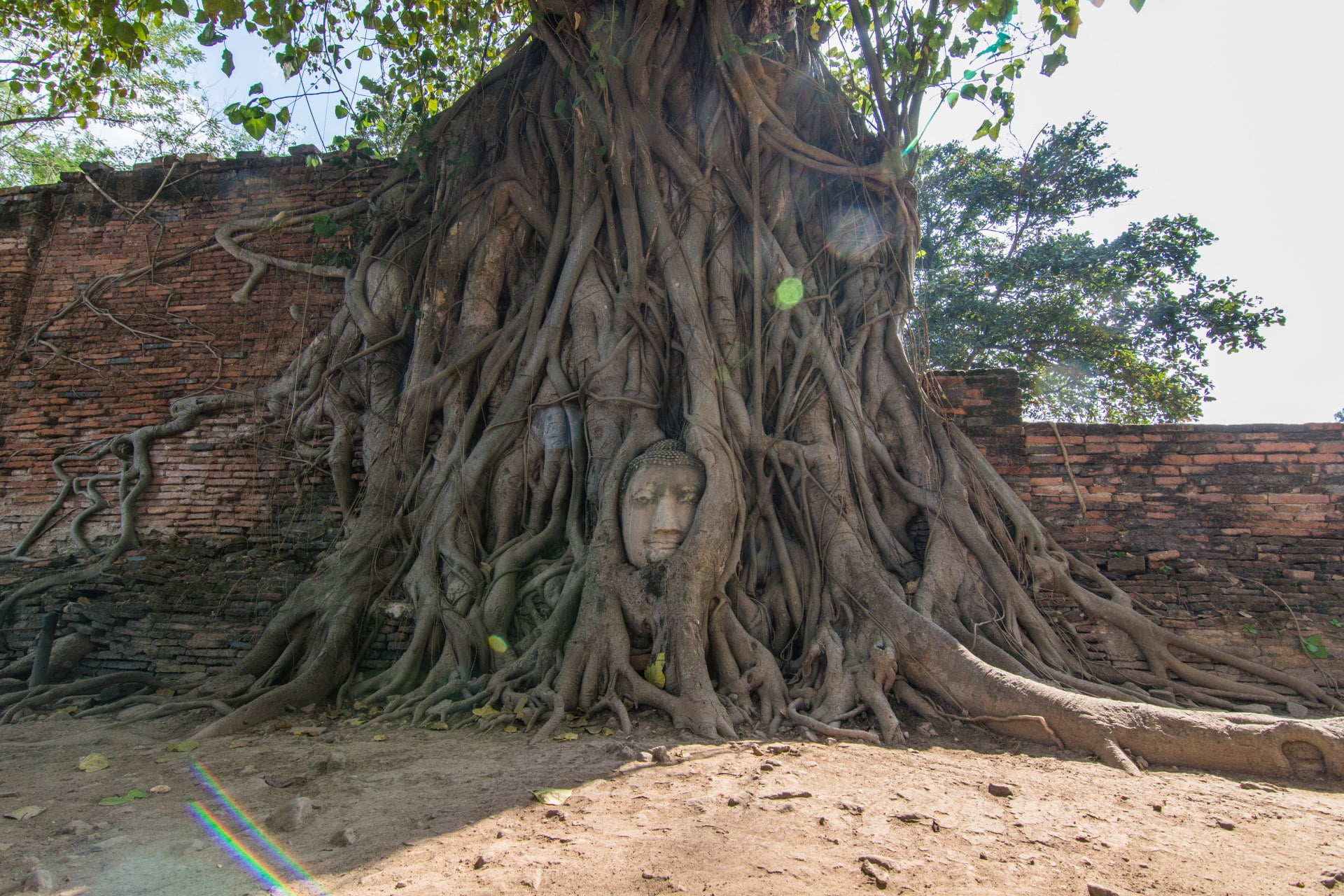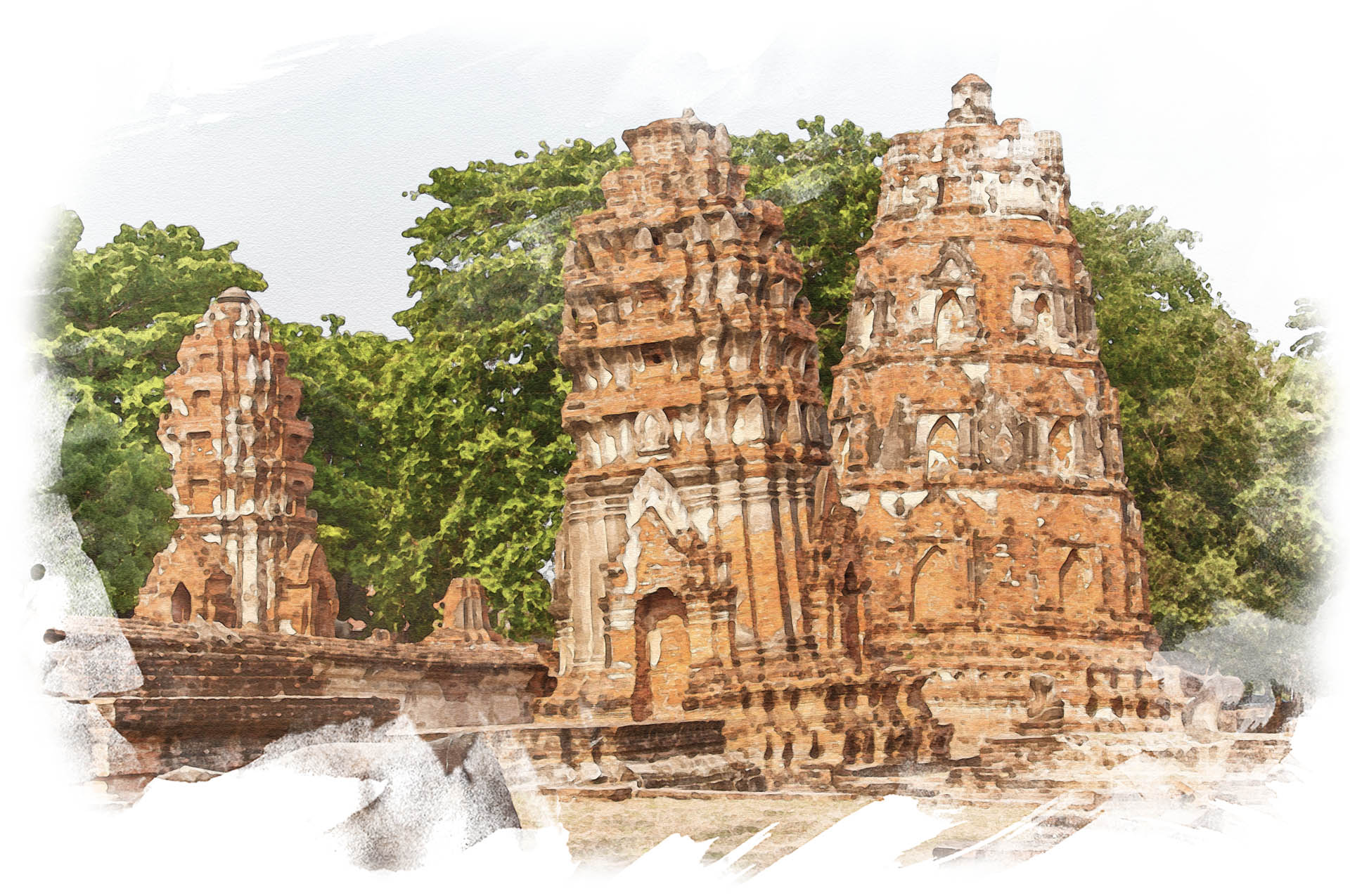Wat Mahathat is probably the most famous temple in the ruins of Ayutthaya. It was one of the most important temples in the Ayutthaya Kingdom, as its name suggests, which can be translated as "temple of the great relic" (which is therefore a common name, found in several temples in the country, notably in Sukhothai Historical Park and Nakhon Si Thammarat to name just these two).
Its attraction comes from its famous Buddha head that was trapped by the roots of a Bodhi tree, a sacred tree in Thailand. And it must be admitted that despite its modest size, this happy coincidence of history and nature stands out and offers an atypical spectacle to the many curious visitors.
Located on the island where most of the old city forming the historical park is located, this ancient monastery included a huge central prang surrounded by a cloister, an imposing main viharn as well as an ubosot (if you are not familiar with these terms, I plan to write a page to explain all that, stay tune). As with many temples in Thailand, there were also a number of chedis and smaller subsidiary viharns.
History of Wat Mahathat
The temple was founded in 1374 by King Borommaracha I, the third ruler to reign over the new kingdom of Ayutthaya. It was built to house important relics of Buddha and to make it the seat of the patriarch, the "leader" of Buddhist monks in Thailand. A prang (chedi based on the architectural codes of Hindu temples, particularly Khmer), was then erected to enshrine the relics of Buddha. It was then one of the largest at its time, approaching 3 m, all placed on a wide base of 40 m.
And while some sources establish the origin of the temple at the founding of the new city as capital, as early as 1350, what remains certain is that King Borommaracha I (r. 1370-1388) carried out important constructions there, as did his nephew and successor, King Ramesuan (r. 1388-1395), who enlarged the temple and above all gave it its current name, Wat Mahathat, the temple of the great relic.
Wat Mahathat was the most important temple of the time and represented the center of Buddhism in the Ayutthaya Kingdom. It was also a royal temple, and as such, it was built near the royal palace, which no longer exists. The kings held important ceremonies here, such as the royal Kathin ceremony, where members of the royal family distributed new robes for the monks.

Last photo showing the central prang still standing, we also note the very lively canal in front (Ayutthaya – 1903: photo from the site ayutthaya-history.com).
Since the city was built around rivers and canals (to see this, take a look at the intersection between Wat Mahathat and the neighboring Wat Ratchaburana, where you will see the remains of a bridge), the ground was soft and unstable. As a result, the central prang collapsed in 1631 during the reign of Prasat Thong (r. 1629-1656), but was restored in 1633 and enlarged in the process, reaching a height of 50 m, including the spire that usually tops the prangs, symbolizing Shiva's weapon (the structure itself is 44 m high).
When the Burmese invaded and largely destroyed Ayutthaya in 1767, Wat Mahathat was burned down, giving the site its current appearance. Or almost… Because the central prang had survived this affront, but it had weakened it and it suddenly collapsed in 1904, shortly after a photo, dated around the end of 1903 – beginning of 1904, immortalized it one last time in its entirety. The building would finally collapse in 1911 but the base would be restored by the Department of Fine Arts to give it its current appearance.
Architecture of Wat Mahathat
The plan of Wat Mahathat follows the concepts of the ancient Khmer temples of Angkor in Cambodia. Temples with pyramidal shapes symbolizing Mount Meru, a mythical mountain considered the axis of the world in Persian, Jain, Buddhist and especially Hindu mythologies. A mountain not to be confused with the Meru volcano located in Tanzania (not far from Kilimanjaro).

Map of Wat Mahathat. Based on image from: Heinrich Damm (User:Hdamm, Hdamm at de.wikipedia.org) / CC BY
1- The central prang and the Buddha gallery
Temples like Wat Mahathat were therefore built to symbolize the Hindu and Buddhist view of the universe.
Mount Meru is then symbolized by the central prang (#1 on the map above), placed on a raised platform in the center of the temple, the center of the universe surrounded by oceans. The central prang is surrounded by four smaller ones at each corner of the gallery, which surrounds the main structure. On the same principle as contemporary Thai temples, there were countless images of the Buddha marking out the gallery, once covered with a wooden roof and of which today only piles of stones remain struggling to reconstitute what was once the jewel of the kingdom.
2- Viharn Luang
Located to the east of the prang, this large hall, 40 m long, was the main prayer hall of the monks. It is listed building no. 2 and marked "Main Vihara" on the map, vihara being a Sanskrit term from which the Thai term used today, Viharn, is derived. Its entrance faces due east to face the sunrise while the other side is connected to the cloister.
The remains of the brick pedestal where the main Buddha statue once stood can be seen, while only one column remains standing, from the original two rows that supported the massive roof of this building. Also surviving, with the help of a concrete crutch, is a piece of the facade, allowing one to see the style of opening that temples of the time had as windows (called "False Window" in English, I can't find an exact translation but I think the term that comes close to it in French would be "fenestra en meurtrière").


3- The Ubosot (ordination room)
Opposite the Viharn, on the west side this time, is the ordination hall (no. 3 on the map). This is where novices were ordained as monks in order to join the monastic ranks. The function of this building, smaller than the Viharn in particular, can be recognized by the steles surrounding the building.
Other structures of the temple
There are many chedis surrounding the building, including those near the famous head (which I show you on the map). One of them, octagonal in shape, is notable since it is rarer. There are also several small secondary viharns, most of which only the base remains, but you will find one whole with its roof, near the West door.
[rating stars="4.5"]
My opinion on the
Wat Mahathat











